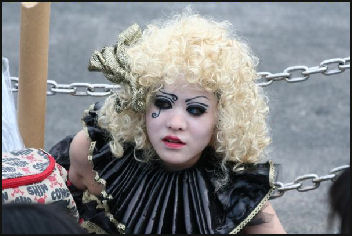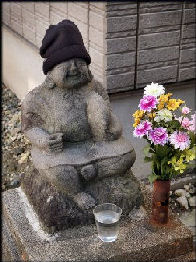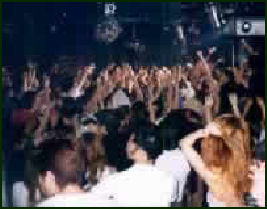JAPANESE PUNK AND UNDERGROUND GROUPS

There are hundreds, maybe even thousands, of underground and punk groups. They include the Cokehead Hipsters, High-Lows, the all-girl Lolita No. 18, Howling Guitars, the Nude Honeys, the Minnesota Voodoo Men, Guitar Wolf, Gang of Gasoline, Astro Babies, and Young Punch. Many Japanese punk groups record on the Howling Bull label.
Baba Takashi, singer in the band “Kubikari” ("Headhunters"), is regarded as the wildest and most obscene live performer In Japan. Simon Bart of the Japan Times described him as "a lethal rock n' roll cocktail made of snatched DNA from Mick Jagger, Johnny Rotten and Iggy Pop." The Jet Boys, another outrageous live act, sometimes take off all their clothes and set their pubic hair on fire and for fun ride surfboards an upward-shooting jets of water in public fountains.
The Boredoms have a cult following in the United States and Europe. Kiyoshiro Imawano caused a stir when he recorded a punk version of “Kimigayo”, the Japanese national anthem, and his record label, Polydor, refused to release it. Lolita 18 dress in bondage gear and are kind of like a cartoon version of the Sex Pistols. Their lead singer lists alcoholism as her favorite hobby. On the “Wild Wacky Party Asia” tour the group did punk versions of enka classics.
Banana Melt has a fairly large foreign following. Devo-like Polyiscs played before large crowds in the United States. Taka Hirose, the bass player in the British group Feeder, grew up in Hozumi in Japan's Gifu Prefecture. He joined the group based on an audition in London. Brahman is a hardcore punk band that has been going at it since 1995.
Frank Spignese write in the Daily Yomiuri, “In the back alley clubs of Shinjuku and Shimo-Kitazawa, punk doesn't merely live. It kicks and screams with almighty abandon.Among some of the more noteworthy groups are Guitar Doors, The 5.6.7.8's and Hi-Hopes... Jail Guitar Doors wear their Joe Strummer pins proudly on their lapels--revolution rockers that put today's young punks to shame. The 5.6.7.8's, famously featured in Quentin Tarantino's Kill Bill, are an all-girl group that sound like Wanda Jackson sitting in with Guitar Wolf, while Hi-Hopes are a punk collective with a Latin tinge that'll have the salsa dancers sashaying through the mosh-pit. [Source: Frank Spignese, Daily Yomiuri, June 24, 2011]
Punk promoter Chris Penhold told the Yomiuri Shimbun that Gasoline “are one of the greatest Japanese bands out there," he said. "They're absolutely brilliant....That's pure rock 'n' roll heart. We've got Joe Alcohol. What can I say, he's a punk. One of the best.”
Good Websites and Sources: Punk J-Underground sound.co.jp/~grind/j-underground ; Punk Rock Confidential punkrockcon.jp ; Guitar Wolf rockofjapan.com/guitarwolf.html ; Hip Hop Ian Coondroys’ Hip Hop in Japan site mit.edu/condry ; Essay on Hip Hop and the Japanese Language macsem.org/PantaleoniPrizePaper ; Essay on J-Pop and Hip Hop aboutjapan.japansociety.org ; Michael Jackson in Japan cbsnews.com ; Wikipedia article on Budokan Hall, where many top foreign acts played Wikipedia ;
Links in this Website: CLASSICAL JAPANESE MUSIC Factsanddetails.com/Japan ; WESTERN CLASSICAL MUSIC IN JAPAN Factsanddetails.com/Japan ; JAPANESE FOLK MUSIC AND ENKA Factsanddetails.com/Japan ; J-POP AND POP MUSIC IN JAPAN Factsanddetails.com/Japan ; J-POP AND POP ARTISTS IN JAPAN Factsanddetails.com/Japan ; ROCK IN JAPAN Factsanddetails.com/Japan ; PUNK, FOREIGN MUSIC, HIP-HOP IN JAPAN Factsanddetails.com/Japan ; YOKO ONO Factsanddetails.com/Japan ; KARAOKE IN JAPAN Factsanddetails.com/Japan ; DANCE IN JAPAN Factsanddetails.com/Japan
Good Websites and Sources on Japanese Music: “The Rough Guide to the Music of Japan” is a CD assembled by Paul Fisher, Short Introduction to Japanese Music asnic.utexas.edu ; Bibliography on Music in Japan aboutjapan.japansociety.org ;Traditional Japanese Music and Dance sfusd.k12.ca.us/schwww ; Wikipedia article on Music of Japan Wikipedia ; Performing Arts Network of Japan performingarts.jp ; Traditional Performing Arts in Japan kanzaki.com ; Hear Music, a World Music Store with a hearjapan.com ; Japanese, Chinese and Korean CDs and DVDs at Yes Asia yesasia.com ; Japanese, Chinese and Korean CDs and DVDs at Zoom Movie zoommovie.com
Guitar Wolf
Guitar Wolf has a particularly nasty reputation. The members of the group claim they subsist totally on beer, enjoy eating piranhas for snacks and their ancestors were aliens that landed on Mt. Fuji and had many babies. They were formed in 1987. As of 2004 they had managed to play drunk for 17 years and still sound fresh.
Their 7th album, “UFO Romantics”, manages to be raw, aggressive and good all at the same time. In 2000, they made a schlocky 2000 horror film called “Wild Zero”. In their live performances they guzzle large amounts of beer, play maniacally and groom their hair on stage.
Guitar Wolf is so loved both in Japan and abroad that a tribute album has been released with artist such as Puffy, D4 and Jim O’Rourke of Sonic Youth doing covers of their favorite Guitar Wolf songs. In 2005 the bassist in the group died of heart attack at age 38. The band vowed to keep going.
Japanese Hip Hop

hip hop Ebisu Break dancing and hip hop dancing are very popular in Japan. Groups of dancers like to gather outside Jidokan in Shibuya and show off their routines. There is even a television show called G Paradise in which dance wanabees are judged and given advise by Sam, the famous dancer teacher of husband of pop idol Namie Amuro.
Hip hop in Japan can trace its origins back to break dancers performing in Tokyo’s Yoyogi Park in late 1983. Some Japanese hip hop groups explore topical social and political issues life school refusal, child abuse, 9-11 and Japanese nationalism.
Hip hop street culture began making itself present in Japan in the 1990s. Kids dressed in baggy jeans, T-shirts, backwards baseball caps and Nikes. They also began braiding their hair and wearing dreadlocks and corn rows and darkening their skin. Now there are record shops that specialize in in providing vinyl for scratchers, areas where graffiti artist can spray paint with impunity and Hip Hop magazines with 120,000 readers.
Japanese Hip Hop Artists

Dragon Ash Popular hip hop groups in Japan include Kick the Can Crew, who put out a great single called “Marsuhe”; Rize, a heavily-tattooed, four-man, rock-rap group; and Rip Slyme. In their videos, these groups dress and move their hands just like black American rappers. Kreva won the award for Best Hip Hop video at the 2007 MTV Video Music Awards Japan.
The rock-hip-hop group Dragon Ash had a hit with “Life Goes On”, which was popular around the time of the 2002 World Cup and was used in J-Phone commercials. KJ, the front man of the for the group, grew up listening to the Red Hot Chili Peppers and the Beastie Boys and spent a year and a half on a homestay in Seattle — the home town of Nirvana — where he immersed him self grunge-garage culture. He formed Dragon Ash when got back, with the group releasing their debut single “ Rainy Day and Day” in 1997. Since then KJ has been on a mission to try to make the Japanese music scene a little less vapid and a little more honest and over the years has built songs around samples by Joan Jett and Smashing Pumpkins and in recent years have infused Brazilian and Latin rhythm into their pieces.
The hip hop duo m-flo has worked with Kanye West and Pharrell in the United States and Kumi Koda and Namie Amuro in Japan. The name is a an abbreviated version of the original name :Meteor Flow.” The main man in the group, Verbal, is a Korean Japanese who real name Ryu Ying Gi. He was born in Tokyo and graduated with a degree in business and philosophy from Boston University. The group’s 4th album “Beat Space Nine” was the No. 1 album in Japan in August 2005.
Book: “Hip-Hop Japan” by Ian Condry (Duke University Press, 2007) “Hip-Hop Japan” by Ian Condry (Duke University Press, 2007) Hip Hop Ian Condroys’ Hip Hop in Japan site mit.edu/condry ; Essay on Hip Hop and the Japanese Language macsem.org/PantaleoniPrizePaper ; Essay on J-Pop and Hip Hop aboutjapan.japansociety.org ; Michael Jackson in Japan cbsnews.com ; Wikipedia article on Budokan Hall, where many top foreign acts played Wikipedia ;
Japanese Techno Artists and Raves

Japanese clubbers Techno music is pretty big in Japan. There is a club scenes but is not as big and drug-fueled as the rave scene in Europe. In 1999, thousands of young Japanese dished out $80 a ticket for the Future Music Festival, Japan’s first large-scale rave event. Many of the top draws at the Fuji Rock Festival are techno acts.
Raves have become increasingly popular in Japan. They are often held outdoors, sometimes at camping sites, and last all night and into the morning. Some attract 1,000 people or more. They’re have been some drug arrests at raves in Gunma and Gifu Prefecture.
Japanese techno artist include Captain Funk (a DJ who has toured the United States and has a contract with Sublime records), Suger Plant (an interesting techno band), Boom Boom Satellites (a Tokyo duo with a drummer) and Fantastic Plastic Machine (led by DJ Tanaka). .
Yellow is a club that specialized in techno and house that was open from 1991 to 2008 in the Nishi-Azubu area of Tokyo. It attracted DJs from London, Paris and New York and had a reputation for not only being the best club in Tokyo but one of the best clubs in the world. Top British deejay Giles Peterson told the Daily Yomiuri, “Any good deejay, ask them what’s the best club in the world and they all say “Club Yellow in Tokyo .” Yellow was known for having an especially fine sound system, It closed because new owners took over the building the club was located in and wanted the club out.
Kitaro is a Japanese New Age synthesizer performer. He won the grammy for Best New Age Album award in 2001. Kitaro was nominated for the same award in 2011 but did not win it this time.
SonarSound Tokyo is modeled on Barcelona's infamous Sonar Festival. The Barcelona event has featured more than 80 Japanese artists during its 18-year history. In 2002, SonarSound Tokyo was launched. [Source: Jane Kitagawa, The Daily Yomiuri, April , 2011]
SonarSound Tokyo's return to the capital's music scene marks the end of a five-year hiatus. Beatink has taken over from the original promoters and consolidated proceedings into a night-and-day event at Shinkiba's Arena with a fund-raising focus. Featured artists that appeared in 2011 included Flying Lotus, Battles, '90s ambient darlings Seefeel, trance-rock locals Rovo, new media artist Ryoji Ikeda, hip-hop stalwart DJ Krush, DJ Karl Hyde and Darren Price of Underworld fame.
Ken Ishii, Audio Active and Fantastic Plastic Machine
Ken Ishii is a techno producer and DJ who has a large following in Europe. Live, he is a straight-ahead techno-dance DJ. On his albums, he produces more multilayered and cerebral tracks that are often accompanied by videos with cutting edge graphics and designs. Ishii was self-described "techno nerd" and "bedroom producer" until 1993 when he was signed by Belgium's R&S record and suddenly was DJing at some of Europe's hottest clubs.
Ishii also created the opening theme song “Fir in White” for the Winter Olympics in Nagano in 1998. The video for Ishii's recording Extra, done with Akira anime director Koji Morimoto won an MTV award for best club video in 1996. Ishii has DJed parties in the Amazon rain forest and performs regularly in China and Turkey. He also records under the names FLR (dance music) and Flare (more experimental stuff).
Audio Active is an experimental-dub group that dresses in astronaut suits and openly sing about the joys of getting high. Their albums “Tokyo Space Cowboys” and “Backed to the Stoned Age” includes tracks like “Stoned Age, Free the Marijuana, Hempire Strike Back, Universal Joint, Weed Specialist” and “Psycho Buds”. A member fo the group told the Daily Yomiuri, “We don’t want to force anyone to smoke marijuana, but we recommend it.”
Fantastic Plastic Machine has be called Japan’s Fatboy Slim and has supported Fatboy Slim on torus in Japan. In Tomoyuki Tanaka is the guy behind FPM. Paul Jackson wrote in the Daily Yomiuri that song is hard to catagorize: “Each track has a distinct identity, Tanaka taking pleasure in splicing together the incongruous and unexpected..club bears, a penchant for 60s movies and odd moments of Braziliance.”
Dango Sankyodai
One of the top-selling singles in 1999 was “Dango Sankyodai” ("Three Dumpling Brothers"), a cute song with a tango rhythm about three dangos (a kind of sweet Japanese dumpling) who fought over who looked best cooked on a stick.
“Dango Sankyodai” was written by marketing genius Masahiko Sato and first heard on a children's television show that aired on NHK. After people began calling in and saying how much they liked the song it was released as a single. Within 12 days, 3.3 million copies were sold. Sweet shops also had trouble keeping dangos on sticks. Thirty dango products were put on the market. For a couple of months it seemed that dangos were all that three- and four-year-olds talked about.
The English translation for the chorus song goes like this:
“Spitted in a stick, dumpling, dumplings
All three in a row, dumplings, dumplings
Drenched in soy sauce, dumplings, dumplings
Dumpling brothers three”
Another children's song about a snack food, “Oyoge! Taiyakikun”, sold 4.5 million copies in 1976.
Japanese Play Foreign Music

Japanese greasers Japanese play almost every style of music. There are good Japanese bagpipers, salsa bands, country-Western groups, Ventures-style guitar bands, Beatles sound-alikes, punk groups. Japan also has produced a number of first class accordion players.
“Oyaji” bands are groups made up of a bunch old guys in their 40s, 50s or 60 that special in playing classic rock n’ roll songs from the 1960s and 70s. Some do favorites by bands like Cream, The Eagles and the Doobie Brothers. Many of them specialize in Ventures songs and use the same kid of guitars as The Ventures There are so many of these bands about that they have competition s of them in Tokyo and Osaka.
Well-regarded Japanese groups that do foreign styles include the Tokyo Ska Paradise Orchestra, Rankin' Taxi (a reggae rapper who toasts in Japanese), and a number of Zairian-influenced groups that sing in Japanese and African languages. Kumiko Tsumori, a 28-year-old native of Osaka, is a highly-praised fado singe in Portugal.
Some Japanese are crazy about flamenco. More homegrown tango recording are released in Japan than Argentina. There are large reggae sections in record stores and many groups that incorporate reggae into their music. Reggae festivals draw around 50,000 people. Shonan no Kaze Exile won the award for Best Reggae video at the 2007 MTV Video Music Awards Japan.
The Japanese salsa group Orqestra De La Luz is very popular in Central and South America and even reached number one on Billboard Latin charts with the song Salsa Caliente del Japon. Latin Americans loved the song and were amazed that Japanese musicians could create such good salsa. Salsa dancing is also quite popular in Japan. In 1993, Orqestra De La Luz became the first group ever to win an award for Cultural Achievement from the United Nations.
In July 2010, Japanese guitarist Jin Oki won a flamenco guitar contest in Murcia, Spain.
See Dance
Japanese Play American Country Music
Country music also has a following in Japan. Around 25,000 Japanese, some in cowboy hats and cowgirl dresses, show up at the annual Country Gold Festival at the foot of Mount Aso in Kumamoto to do the two-step.
The primary mover and shaker behind country music in Japan is "Good Time" Charlie Nagatani. Resembling a Japanese version of Waylon Jennings, he is the organizer of Country Gold and the leader Japan's most popular country band.
Nagatani was first exposed to country music in 1955 on his 20th birthday. He liked the music so much he quit college and formed a band, Charlie's Cannon Balls, and devoted his energy to country music. He ran a honky bar for many years before devoting himself to touring. He has played in almost every city in Japan and is popular at American military bases in Asia.
When asked what motivates him, Nagatani told National Geographic, "I wanted to introduce this wonderful music, and true American culture, to the Japanese people."
Image Sources: Japan Zone and Ray Kinnane
Text Sources: New York Times, Washington Post, Los Angeles Times, Daily Yomiuri, Times of London, Japan National Tourist Organization (JNTO), National Geographic, The New Yorker, Time, Newsweek, Reuters, AP, Lonely Planet Guides, Compton’s Encyclopedia and various books and other publications.
Last updated July 2011
